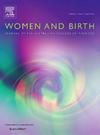助产士如何了解、理解文化安全并将其融入对原住民妇女和家庭的护理中?定性探索。
IF 4.4
2区 医学
Q1 NURSING
引用次数: 0
摘要
问题:要求助产士为原住民妇女和家庭提供基于文化安全的护理。最近的文献表明,助产士对文化安全的理解以及如何将其转化为实践存在很大差异。这种差异需要进一步探讨:澳大利亚专业助产士守则和标准规定,必须提供基于文化安全的护理。了解原住民的历史和文化如何影响他们的健康和福祉至关重要,这就要求助产士认识到这可能会如何影响护理工作。目的:确定澳大利亚助产士对文化安全的认识和理解,以及在护理原住民妇女和家庭时如何将其转化为实践:方法:开展一项定性研究。通过对 12 名在澳大利亚执业的助产士进行半结构化访谈收集数据。对数据进行了转录和主题分析:确定了三个主题:社会与系统"、"了解与理解 "以及 "个人素质、参与与合作",这些主题突出了澳大利亚文化安全教育及其与助产实践相结合的优势与不足:讨论:提供孕产妇护理的医疗系统仍然根植于西方生物医学理念,这影响了文化安全在各个层面的实践。助产士开始了解殖民化对原住民家庭健康和福祉的持续影响,但在努力提供文化安全护理时仍面临挑战:文化安全必须在组织层面得到重视,助产士可以在这些组织中参与由准备充分的教育者领导的、以孕产为基础的真实教育计划。本文章由计算机程序翻译,如有差异,请以英文原文为准。
How do midwives learn about, understand, and integrate Cultural Safety into their care of First Nations women and families? A qualitative exploration
Problem
Midwives are required to provide care based on Cultural Safety for First Nations women and families. Recent literature has suggested that midwives' understanding of Cultural Safety and how it translates into their practice differs widely. This disparity requires further exploration.
Background
The Australian professional midwifery codes and standards state that there is a requirement to provide care based on Cultural Safety. It is critical to understand how First Nations people’s history and culture impacts their health and wellbeing, requiring midwives to recognise how this may impact care.
Aim
To determine Australian midwives’ knowledge and understanding of Cultural Safety and how this translates into their practice when caring for First Nations women and families.
Methods
A qualitative study was undertaken. Data were collected via semi-structured interviews with 12 midwives practicing in Australia. Data were transcribed and thematically analysed.
Findings
Three themes were identified: ‘Society and Systems’, ‘Knowingness versus Understanding’, and ‘Personal Qualities, Engagement and Partnerships’ which highlight the strengths and deficits of Cultural Safety education and its integration into midwifery practice in Australia.
Discussion
Health systems providing maternity care remain rooted in Western biomedical philosophies, which influences the practice of Cultural Safety at all levels. Midwives are beginning to understand the ongoing impact of colonisation on the health and wellbeing of First Nations families, but still face challenges when striving to provide culturally safe care.
Conclusion
Cultural Safety must be valued at an organisational level, in which midwives can engage in authentic, maternity-based educational programs led by suitably prepared educators.
求助全文
通过发布文献求助,成功后即可免费获取论文全文。
去求助
来源期刊

Women and Birth
NURSING-OBSTETRICS & GYNECOLOGY
CiteScore
7.20
自引率
13.20%
发文量
371
审稿时长
27 days
期刊介绍:
Women and Birth is the official journal of the Australian College of Midwives (ACM). It is a midwifery journal that publishes on all matters that affect women and birth, from pre-conceptual counselling, through pregnancy, birth, and the first six weeks postnatal. All papers accepted will draw from and contribute to the relevant contemporary research, policy and/or theoretical literature. We seek research papers, quality assurances papers (with ethical approval) discussion papers, clinical practice papers, case studies and original literature reviews.
Our women-centred focus is inclusive of the family, fetus and newborn, both well and sick, and covers both healthy and complex pregnancies and births. The journal seeks papers that take a woman-centred focus on maternity services, epidemiology, primary health care, reproductive psycho/physiology, midwifery practice, theory, research, education, management and leadership. We also seek relevant papers on maternal mental health and neonatal well-being, natural and complementary therapies, local, national and international policy, management, politics, economics and societal and cultural issues as they affect childbearing women and their families. Topics may include, where appropriate, neonatal care, child and family health, women’s health, related to pregnancy, birth and the postpartum, including lactation. Interprofessional papers relevant to midwifery are welcome. Articles are double blind peer-reviewed, primarily by experts in the field of the submitted work.
 求助内容:
求助内容: 应助结果提醒方式:
应助结果提醒方式:


